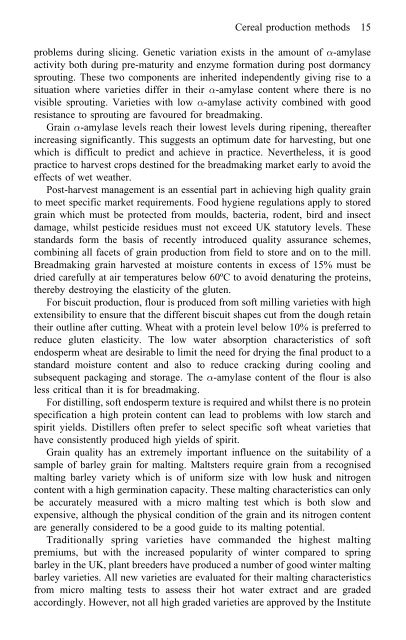Cereals processing technology
Cereals processing technology
Cereals processing technology
You also want an ePaper? Increase the reach of your titles
YUMPU automatically turns print PDFs into web optimized ePapers that Google loves.
Cereal production methods 15<br />
problems during slicing. Genetic variation exists in the amount of -amylase<br />
activity both during pre-maturity and enzyme formation during post dormancy<br />
sprouting. These two components are inherited independently giving rise to a<br />
situation where varieties differ in their -amylase content where there is no<br />
visible sprouting. Varieties with low -amylase activity combined with good<br />
resistance to sprouting are favoured for breadmaking.<br />
Grain -amylase levels reach their lowest levels during ripening, thereafter<br />
increasing significantly. This suggests an optimum date for harvesting, but one<br />
which is difficult to predict and achieve in practice. Nevertheless, it is good<br />
practice to harvest crops destined for the breadmaking market early to avoid the<br />
effects of wet weather.<br />
Post-harvest management is an essential part in achieving high quality grain<br />
to meet specific market requirements. Food hygiene regulations apply to stored<br />
grain which must be protected from moulds, bacteria, rodent, bird and insect<br />
damage, whilst pesticide residues must not exceed UK statutory levels. These<br />
standards form the basis of recently introduced quality assurance schemes,<br />
combining all facets of grain production from field to store and on to the mill.<br />
Breadmaking grain harvested at moisture contents in excess of 15% must be<br />
dried carefully at air temperatures below 60ºC to avoid denaturing the proteins,<br />
thereby destroying the elasticity of the gluten.<br />
For biscuit production, flour is produced from soft milling varieties with high<br />
extensibility to ensure that the different biscuit shapes cut from the dough retain<br />
their outline after cutting. Wheat with a protein level below 10% is preferred to<br />
reduce gluten elasticity. The low water absorption characteristics of soft<br />
endosperm wheat are desirable to limit the need for drying the final product to a<br />
standard moisture content and also to reduce cracking during cooling and<br />
subsequent packaging and storage. The -amylase content of the flour is also<br />
less critical than it is for breadmaking.<br />
For distilling, soft endosperm texture is required and whilst there is no protein<br />
specification a high protein content can lead to problems with low starch and<br />
spirit yields. Distillers often prefer to select specific soft wheat varieties that<br />
have consistently produced high yields of spirit.<br />
Grain quality has an extremely important influence on the suitability of a<br />
sample of barley grain for malting. Maltsters require grain from a recognised<br />
malting barley variety which is of uniform size with low husk and nitrogen<br />
content with a high germination capacity. These malting characteristics can only<br />
be accurately measured with a micro malting test which is both slow and<br />
expensive, although the physical condition of the grain and its nitrogen content<br />
are generally considered to be a good guide to its malting potential.<br />
Traditionally spring varieties have commanded the highest malting<br />
premiums, but with the increased popularity of winter compared to spring<br />
barley in the UK, plant breeders have produced a number of good winter malting<br />
barley varieties. All new varieties are evaluated for their malting characteristics<br />
from micro malting tests to assess their hot water extract and are graded<br />
accordingly. However, not all high graded varieties are approved by the Institute



